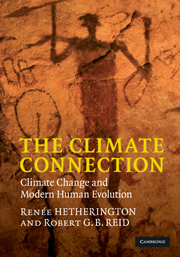Book contents
- Frontmatter
- Contents
- Foreword
- Preface
- Acknowledgements
- 1 Introduction
- Part I Early human history
- 2 From ape to human: the emergence of hominins
- 3 Human behavioural evolution
- 4 The migrations and diaspora of Homo
- Part II Climate during the last glacial cycle
- Part III The interaction between climate and humans
- Appendices: The biological background to the story of evolution
- References
- Index
- Plate section
2 - From ape to human: the emergence of hominins
Published online by Cambridge University Press: 05 August 2012
- Frontmatter
- Contents
- Foreword
- Preface
- Acknowledgements
- 1 Introduction
- Part I Early human history
- 2 From ape to human: the emergence of hominins
- 3 Human behavioural evolution
- 4 The migrations and diaspora of Homo
- Part II Climate during the last glacial cycle
- Part III The interaction between climate and humans
- Appendices: The biological background to the story of evolution
- References
- Index
- Plate section
Summary
Introduction
Humans are not descended from apes. However, we do share a common ancestor and must accept that our place in the world has been, and continues to be, a part of the natural world. It was Aristotle's scala naturae that first placed humans at the top of the Ladder of Life, followed by apes, cetaceans, and other animals, in descending order of complexity, down to lower plants on the bottom rung. Aristotle perceived the ladder as a series; what he did not grasp was an evolutionary process that would see one type change into another. This concept of a primordial form that progresses in complexity and diverges in form, although frequently attributed to Charles Darwin, must be ascribed to Georges Louis Leclerc Buffon (1707–88), who stated: ‘If, for example, it could be once shown that the ass was but a degeneration from the horse – then there is no further limit to be set to the power of nature, and we should not be wrong in supposing that with sufficient time she could have evolved all other organized forms from one primordial type’ (quoted in Butler, 1879, pp. 90–1).
Charles Darwin's grandfather Erasmus postulated in Zoonomia (1794) that all life could have evolved from a primordial fibre. Lamarck (1744–1829) later wrote in his L'Histoire naturelle des animaux sans vertèbres (1815–22) that evolution was progressionistic – moving in the direction of complexity at a fixed rate.
- Type
- Chapter
- Information
- The Climate ConnectionClimate Change and Modern Human Evolution, pp. 15 - 38Publisher: Cambridge University PressPrint publication year: 2010



